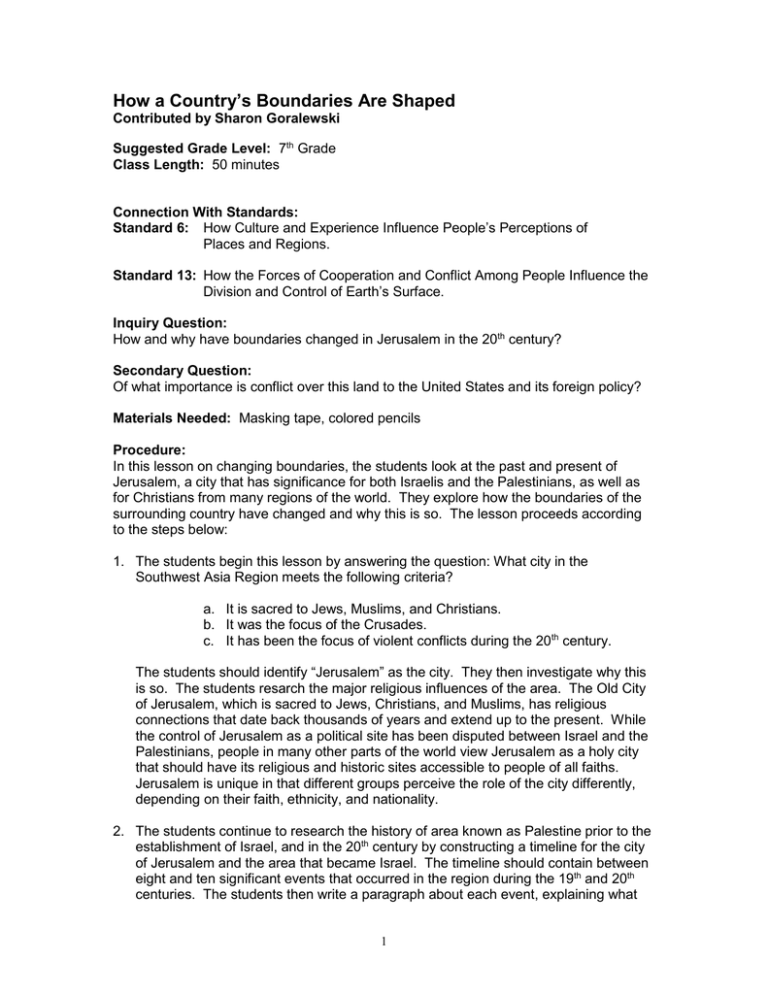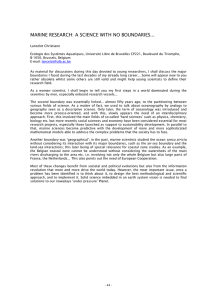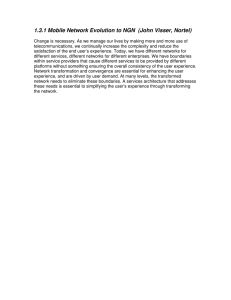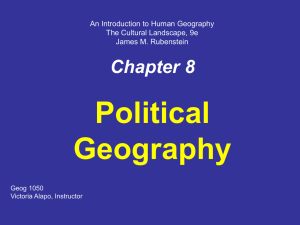How a Country’s Boundaries Are Shaped
advertisement

How a Country’s Boundaries Are Shaped Contributed by Sharon Goralewski Suggested Grade Level: 7th Grade Class Length: 50 minutes Connection With Standards: Standard 6: How Culture and Experience Influence People’s Perceptions of Places and Regions. Standard 13: How the Forces of Cooperation and Conflict Among People Influence the Division and Control of Earth’s Surface. Inquiry Question: How and why have boundaries changed in Jerusalem in the 20th century? Secondary Question: Of what importance is conflict over this land to the United States and its foreign policy? Materials Needed: Masking tape, colored pencils Procedure: In this lesson on changing boundaries, the students look at the past and present of Jerusalem, a city that has significance for both Israelis and the Palestinians, as well as for Christians from many regions of the world. They explore how the boundaries of the surrounding country have changed and why this is so. The lesson proceeds according to the steps below: 1. The students begin this lesson by answering the question: What city in the Southwest Asia Region meets the following criteria? a. It is sacred to Jews, Muslims, and Christians. b. It was the focus of the Crusades. c. It has been the focus of violent conflicts during the 20th century. The students should identify “Jerusalem” as the city. They then investigate why this is so. The students resarch the major religious influences of the area. The Old City of Jerusalem, which is sacred to Jews, Christians, and Muslims, has religious connections that date back thousands of years and extend up to the present. While the control of Jerusalem as a political site has been disputed between Israel and the Palestinians, people in many other parts of the world view Jerusalem as a holy city that should have its religious and historic sites accessible to people of all faiths. Jerusalem is unique in that different groups perceive the role of the city differently, depending on their faith, ethnicity, and nationality. 2. The students continue to research the history of area known as Palestine prior to the establishment of Israel, and in the 20th century by constructing a timeline for the city of Jerusalem and the area that became Israel. The timeline should contain between eight and ten significant events that occurred in the region during the 19th and 20th centuries. The students then write a paragraph about each event, explaining what 1 happened and why it was important. The students also explain how those events were important to the United States and how they affected US foreign policy. 3. The students divide into five groups, with each group sketching a map, or using the outline map distributed by the teacher, of the region of Palestine and Israel for a specific time era. The map shows changes in boundaries and the different names for countries and groups of people who lived there. As a class, they determine the scale and the colors for the key so that the maps can be easily compared. One map would show boundaries from the 19th century until 1920. The second would be for 1920 until 1947. The third map would show boundaries from 1947 until 1967. The fourth map would be of the area after the 1967 Six-Day War. The fifth map would be of Israel and the Palestinian Administrative Authority areas today, including recent changes or boundary adjustments. These maps should be posted on the wall and discussed as a timeline of boundary changes in the region. 4. Using masking tape on the floor of the classroom, the students outline and approximate shape for Israel and the Palestinian Administrative Authority areas. The area outlined should be about twelve feet from north to south and four feet from east to west at its widest point. Label surrounding countries and water. Students volunteer, or are assigned by the teacher, to be residents in specific locations of the larger area, discussing which ethnic group they represent; Israeli, Palestinian, or Christian. Beginning with the earliest boundaries shown on the sketch maps that were researched, each group of students uses tape to show the boundaries of Israel and Palestine at a particular time. Each new era has a new set of boundaries. The students must stay in the original locations and with the same ethnic groups they chose, or were assigned. After each “retaping” or boundary change, the students discuss how they feel about the change. In some cases, they will be in the same location, but with new political and ethnic conditions. Appoint students to record the events on the board. Using a column for each era, list the probable perceptions (emotions, feelings, attitudes) of Jews, Muslims, and Christians to boundary changes. Develop this chronologically so that residual feelings or preferences from any of the groups can be traced back through time. This emotive perception of past and current boundaries and control of the land (either rural or urban) is a major issue in the region. 5. In conclusion, after research and discussion, the students are assigned to write a letter to the current political leader of Israel, or the political leader of the Palestinian Administrative Authority. The letter identifies the geographic (boundary) problems as the students have researched them and lists several possible solutions to be considered. Classmates then exchange the letters and read them. The students then take a position on the solution(s) suggested and write a short reply. Positions may be either in support of or opposed to the suggested solution, but should be supported by social studies information. Additional Work: The students follow reports in the news media from the region and compare the boundary discussion with the historic boundary issues they researched. They also consider the solutions that are presented via the international and national media and compare them to their solutions, and the positions taken by the various sides in the dispute. They should evaluate how the conflict in this region affects United States 2 foreign policy towards the region by the amount of time the US Secretary of State, the President, and the Congress devote to the conflict. Evaluation: The students are assessed in two ways in this lesson. Their participation in the mapping of the boundaries demonstrates their comprehension of the changing boundaries in this region. The underlying difficulties for either the Israelis or Palestinians in giving up control of the land should be expressed as a major obstacle to finding a lasting peace in this region of long-standing conflict. The letter that they write presents a possible solution to the problem and demonstrates their comprehension and evaluation of the issues within the region. Relevant Resources: Student Resources: Frucht, Leora Eren. “No Easy Commute.” The Jerusalem Post (2001). 23 January 2001: http://www.jpost.com “Welcome to Palestine.” Palestine Net (December 2000). 23 January 2001: http://www.palestine-net.com Teacher Resource: Zeller, Tom. “Sticks and Stones: A Deadly Brand of Child’s Play.” The New York Times, Week in Review, 8 Oct. 2000:55. 3



